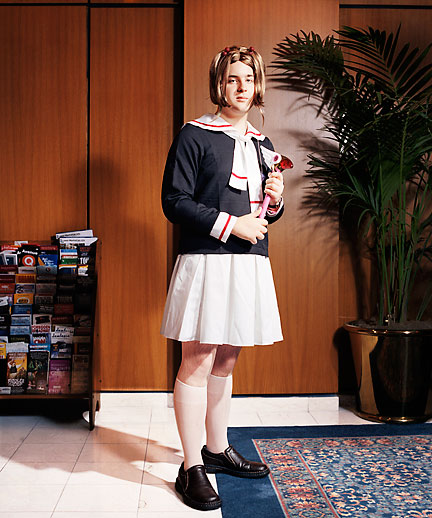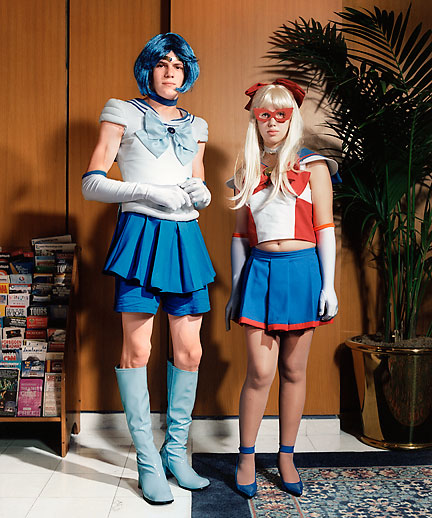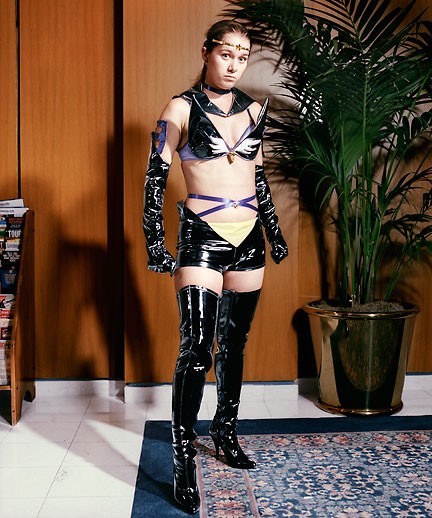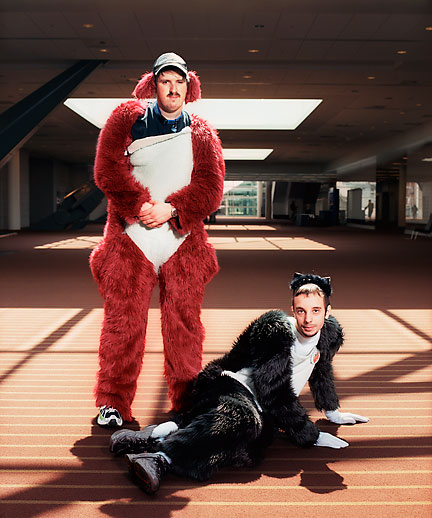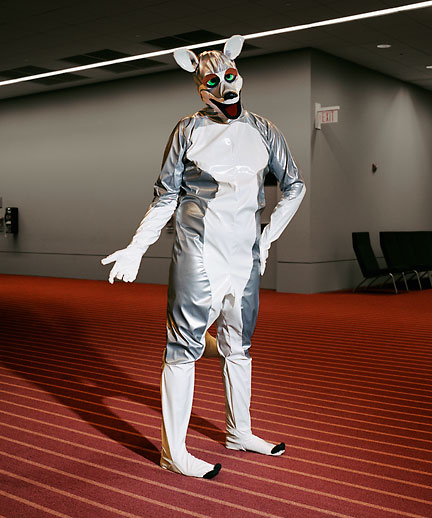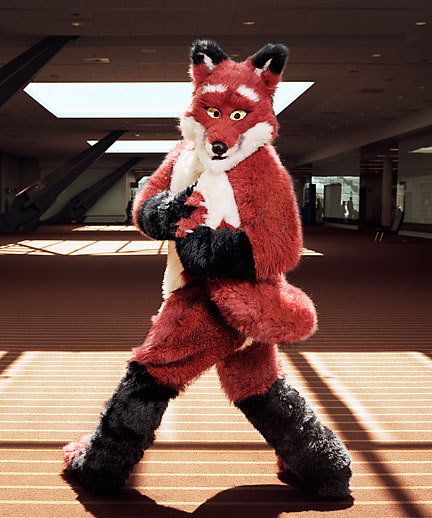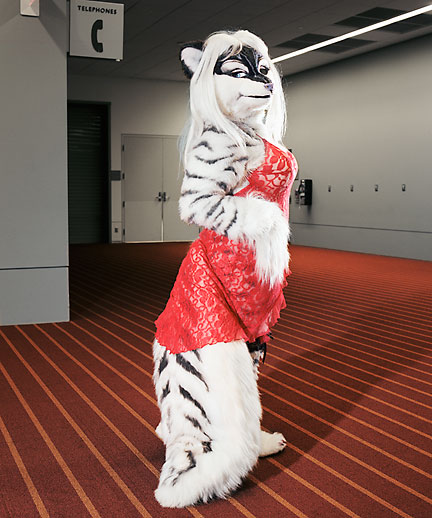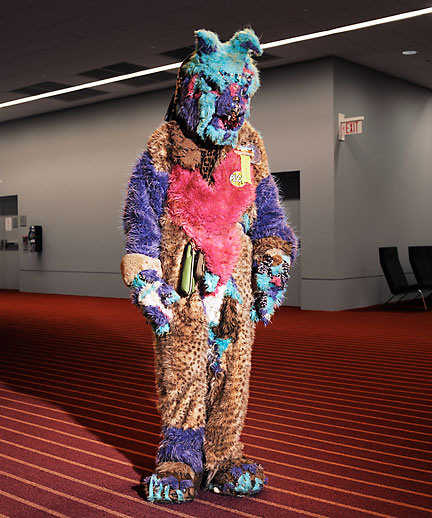Your work on Buffy Fandom, specifically the Bronze, explores the ways that online communities empower some participants at the expense of others. What lessons might we take from this research which would help us to better understand the ways that racial exclusion operates in fandom?
Last week I was reading the N'Gai Croal commentary on the Resident Evil 5 trailer - I read both his interview with MTV and the online discussion that followed, and I think that the interchange is a good representative of the ways in which a fandom community (or in this particular case, a fandom public sphere or audience) exposes its multiple boundaries The dominant themes therein were 1) that talking about race is racist, 2) that Croal and anyone else that saw anything racist about the trailer were, in addition to racist, unhealthily focused upon race and/or crazy, and 3) that if the trailer did contain disturbing racial imagery, it was not the intent of the designers, and thus those who did see such imagery should either ignore it, or forgive, forget, and move on, since the fault of seeing it was their own problem. While Croal kept making the point that he was talking about the trailer, not the game (which no one had seen or played), and that he was talking about it in its larger cultural context, the general exhortation to "move on" from race was repeated quite a bit.
This audience response contains several classic narrative points in what we might call the post-civil rights or indeed post-racial era, discussed in #1 above, that critical race scholars have identified. 1) Rearticulation of race and racism (Omi & Winant; Feagin; Bonilla-Silva; Moore); 2) Innocence/Intent (Moore) (usually of whites, but in the commentary responding to Croal it is extended to the Japanese game designers, as if Japan has no history of its own racial and ethnic constructions); and 3) Rearticulation of objectivity. Critical race scholars argue that the frame that only racists see race functions to turn the legal notion that race is a suspect class on its head by decontextualizing it from its historical and legal intent.
This whole framework can be seen in this statement from one of the responses to Croal: "Well, how about you flip that around and consider the possibility that you are trying to make something out of nothing. Maybe these gamers don't see the racism because they aren't racist and they don't see it as an issue of color. If you want to know what is keeping racism alive in America, then I suggest you start by looking in the mirror and build from there."
Croal and a few members of the audience/fandom address this framing of the issue several times in the course of the discussion, although the dominant narrative likely remains the take-away message, as the bulk of the comments remain in the post-racial frame. The discussion is itself an example of a great deal of discussions about race in the U.S. - people mostly talking past each other with a distinct lack of empathy - I saw the exact same narratives played out during the recent election, particularly in comments responding to Obama's speech on race that appeared online at the New York Times, with one of the most mind-boggling (to me, a biracial person whose family members don't seem to be all that angst-ridden about having discussions about race and racism) being a comment that Obama was a horrible, horrible person for talking about his grandmother's having told him about her own fears of black men. That outing her in this way was disrespectful.
That this is a framework reflective of available cultural narratives, and not something which naturally resides in people based on their group memberships per se is reflected in that comments in the critical race frame are made by whites, and comments in the dominant racial frame are made by non-whites,
Michelle says:
July 22nd, 2008 at 2:07 am
Hello,
Im black...I've seen the trailer... It is a video game; if you dont like it don't watch it or play it! Maybe you, instead of writing about a video game trailer, you should be discussing something important like the AIDS problem in Africa or anything else of importance in the world. Games are for fun; an escape. Nothing else.
Sucka.
This comment also reflects the frame I noted above that entertainment media, being non-serious, does not matter. Anything goes because it's "for fun," and to "escape" the real world where serious and "important" problems occur. This frame is addressed by some in the discussion, as they argue that media is art, and games involve artistic expression, and thus have cultural meaning, which is as appropriate an arena for serious discussion and deconstruction as anything else.
It is well established at this point that the highest rated television shows among African-Americans are often the lowest rated shows among white Americans and vice-versa. (A notable exception are reality television programs, such as Survivor and American Idol). What are the implications of this data for the future of fandom? Are there things that fan communities might do to become more racially diverse? And is this even the best response to this configuration of tastes and interests?
I'm reminded how integration is defined by whites (10% black) and by blacks (50% black) (see Larry Bobo's work on residential integration). I'm also reminded of Herbert Gans's argument that people are entitled to the culture they want. That we value different media because we have different taste cultures shouldn't be either surprising or problematic per se. I think it becomes a problem when, in part because we're mainly talking about commercial products, taste cultures reflective of smaller and/or less powerful parts of the overall potential audience don't actually get to reach the audiences that are entitled (in Gans's terms) to access those media. The Tyler Perry empire is an interesting phenomenon - his media is extremely popular in the African-American community, and within that market segment, he dominates stage, TV, and film; he's a mogul, and in "mainstream" venues like Entertainment Weekly, his success has come as quite the shock, although his stage work has a deep connection to the historical "chitlin' circuit." Obviously, his success reflects not just an existent market for black multimedia, but a change in the buying power of those who make up that market - this segment can support not just media, but multiple forms of media, and increasingly expensive media. It's one thing to have your market segment and "mainstream" audiences buy your work (see hip hop); it's another to gross $5,000,000 on one play in 5 months in one city when the vast majority - if not all - of the audience comes from one group. These are market concerns that producers are certainly paying attention to. As I suggested above, I don't think audiences are necessarily as segmented as we are when we are talking about things like residence - media flows more freely than does real estate. Perhaps the most a particular fandom community might do in terms of diversity is recognize that freer flow, and not police their boundaries quite so vehemently when it comes to discussions of race, gender, sexuality, class, etc. vis-Ã -vis their favorite media products.
You've written an essay explaining the ways you draw on your own autobiography to inform your pedagogy about race across a range of academic subjects. How would you mobilize your autobiography to talk about race in a course on fan studies?
Okay, here I guess I should provide an autobiographic brief, so here are some possibly relevant facts about me: I am a 39-year-old, heterosexual, biracial African American woman, nominal Unitarian, sociologist who is 8 1/2 weeks post-partum with my first child, and married to a white man. I was born and raised in Kansas City, MO, attended college in Iowa, and graduate school in Illinois. I now live in Texas. I'm about as Midwestern (and I'd like to deconstruct that identity with you when you have the time) as you can get, although I am also fairly well-traveled and not particularly "small-town," and due to my advanced degrees, part of a statistical elite. I was raised, by both my parents, as a feminist, and self-labeled as such before the age of eight. I'm a geek, and get my original fan cred mostly from Trek and comics. This is what you get when you're raised by Linc and Julie in their real world sci fi/comic fan, history/political science major, social worker incarnations. Or something.
Anyway, this is the answer in which I get more ranty, and less academic. A while ago, I was reading an article about the Sabbath in Israel, and I was struck by the following, "Who talks of 'public culture' anymore? Everybody talks about popular culture, but ours is the era of segmented markets, when hip-hop fans share no common ground with, say, OC addicts. Communitarians talk of civil society, but the voluntarism and community activity they demand is (and ought to be) local, not national; there's no obvious way to bring all those Knights of Columbus councils and bowling teams in contact with each other."
This part in particular is what chapped my hide: when hip-hop fans share no common ground with, say, OC addicts.
Because. You know. I think that's a creation of marketing and market research which, I think, is like a lot of survey research - people are more likely to be forced into boxes, and those boxes are more likely to be reified into mutually exclusive categories, when you only have boxes to check, and when your analysis is driven by a methodology (e.g. regression analysis) that forces you towards parsimony. It's not that there aren't patterns and segments, but I think a lot of that may be overdrawn... I mean, if I have to read one more article about fanboys that ignores the documented history of the myriad of ways in which women have participated in the fan-culture of the supposedly male bastion of science fiction, I may have to hit someone with my shoe. I think this Slate author is ignorant of fandom in general, and did the thing that many do - looked at the surface of hip-hop and The O.C., and decided he knew who the actual audience is for each, and that never the twain shall meet (and he also ignored the already widely documented potential of the Internet to bring together Knights of Columbus bowlers). That's easy to do when the face of the product is fairly homogeneous, but from this example alone, it seems to me that he never talked at length with any hip-hop or O.C. fan - just on my LJ flist alone I can name five people who like both of these things. I myself have been known to put Missy Elliot, the Dixie Chicks, Bob Marley, and The Clash in the CD player (yeah, I don't have an iPod) while I read back issues of X-men. It's possible that I am just weird, and that I just hang around with weird people, but as a researcher, I prefer to think we should at least investigate audiences before pronouncing who likes what and who doesn't talk to whom...
I suppose, then, I would mobilize my autobiography and the autoethnographic technique - in the same way I already do - to question the clear-cut boxes of market segments and fandom identities. Both of these ways of seeing the audience are focused upon a concern with boundaries - on the one hand, the audience is defined by outsiders (the market researcher) and on the other the audience is being defended from outsiders by those on the inside (the fans), race is ultimately about group boundaries as well. Examining how these three concepts interact and overlap would, I think, be useful in a course on fandom.
I am seeing more and more stories out there discussing Barack Obama's
background as a fan (someone who cites Star Trek in casual conversations, who reads comics, who enjoys Harry Potter, etc.). What kind of role model might Obama represent as we rethink the relationship between race and fandom? How does this geek image connect to historical constructions of black identity in the United States?
Hmmmm. I think the relationship between race, media and fandom, like that between gender, media and fandom, is very interesting - again, media constructions of media geeks tend to be dominated by images of white heterosexual men, and my personal favorite media-geek-media (is that a word???) are those that acknowledge that reality, and comment upon it. Free Enterprise's Eric when he says, "Robert. Dude. Great party but... where are all your friends of color?" The same film's Claire, who takes down Robert in the comic book store for assuming she's buying a comic for her boyfriend. Chasing Amy's Hooper X, the gay black comic artist who must front a particular black identity to be taken seriously. Currently, I'm sort of in love with The Big Bang Theory, as it's peopled with academics who are media geeks, even if it mostly does replicate the fanboy stereotype... I have conversations like those guys do, that start in my professional jargon and end in letting everyone know that Ho-ho's are a vital part of my cognitive process. In a subculture that is into dressing up as our favorite characters, Black geeks usually have Uhura on one end, and Urkel on the other - liking geeky pop culture is different than getting any kind of cred by actually being a geek. But really, Wu-Tang Clan is pretty damn geeky if you ask me, especially The Rza. I mean. Wu-Tang Clan. Let's announce our geekstyle love of subcultual fandom in a more blatant way!
Geek and Black are not normalized co-identities, but really, if geeks' specialized knowledge is more or less impenetrable to outsiders, who's geekier than Samuel R. Delany?
Have we ever had a geek president? The intellectual aspects of geekitude (geekness? geekosity?) have certainly always (okay, mostly) been present in the oval office. But there's a certain aspect of pop culture savvy to being a geek, however much we might be marginalized by the, um, extremity of our fandom love. If Barack Obama's election says something about deconstructing aspects of political power as white, it says just as much about deconstructing elite intellects as bastions of whiteness, and deconstructing the geek as a white's only identity...
Sarah N. Gatson is an Associate Professor of Sociology at Texas A&M University-College Station. She earned her B.A. at Cornell College in 1991, and her M.A. (1992) and Ph.D. at Northwestern Univserity (1999). In addition to her work on Internet community (Interpersonal Culture on the Internet - Television, the Internet, and the Making of a Community, with Amanda Zweerink, The Edwin Mellen Press, 2004), she collaborated on a NIH/NIDA-funded project looking at Computer-Mediated Communication as it intertwines with Rave and Drug-using subcultures, which has just been released as a book: Real Drugs in a Virtual World: Drug Discourse and Community Online, edited by Edward Murguia, Melissa Tackett-Gibson, and Ann Lessem (Lexington Books). Her research interests are centered on how people organize themselves in terms of community and citizenship. Her graduate work focused upon gender and race as they intersect with these processes, their significance as cultural systems, and as ideologies that permeate all our lives. Her work has moved back and forth from a focus on policy and law, and thus the more formal process of citizenship, to a more generalized focus on the micro- to macro-level processes of identity, community, and citizenship, and the connections between these processes. Some of her work has been published in Contemporary Sociology, Law & Social Inquiry, Research in Community Sociology, Qualitative Inquiry, Qualitative Research, and Feminist Media Studies. Currently, she is a collaborator on a project whose focus is the development of scientific learning and professional communities and future scientists, particularly focusing on access to education, mentors, and scientific networks for underserved segments of the population. Innovation in both offline and online methods to increase access are being explored. This project currently has NSF funding as a Research Experiences for Undergraduates site, a Research Experiences for Teachers site, and a Bioengineering and Bioinformatics Summer Institute site, and NIH funding as an R25 site to increase diversity in research personnel, and is housed at the TAMU College of Veterinary Medicine, Department of Physiology & Pharmacology. Her teaching interests include the sociology of law, race and ethnicity, popular culture, qualitative methodology, marriage and family, and the introduction to sociology; all her course are framed with attention to intersections of race, gender, class, & sexuality.

